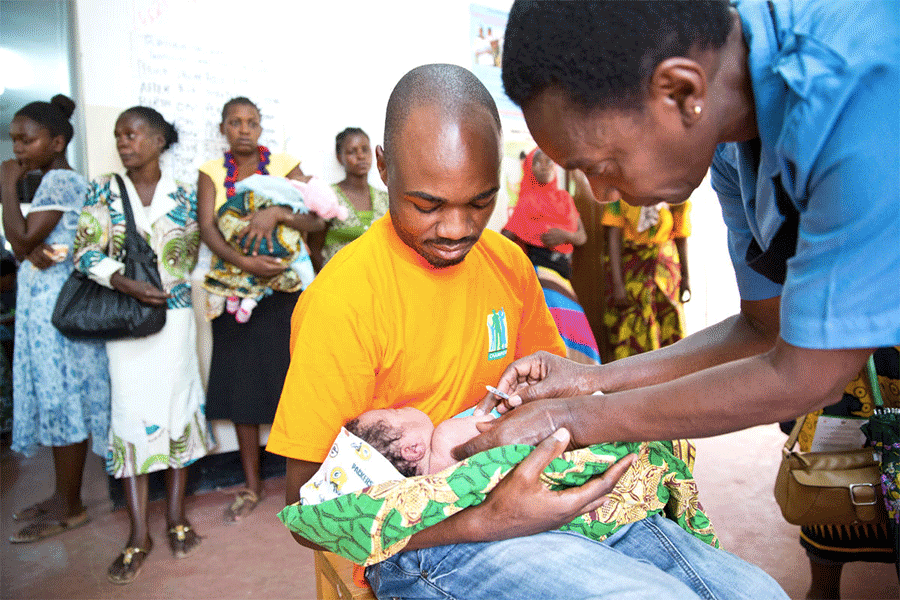Why is it Recommended to Include Men and Boys in the RMNCH Conversation?
The webinar, Transforming Gender Norms: Innovative Approaches to Working with Men and Boys for Better RMNCH, presented three comprehensive project examples for including men and boys in Reproductive Maternal Newborn and Child Health (RMNCH) programming.


 Presenters included Jennifer Orkis MHS, from Johns Hopkins Center for Communication Programs, who discussed how the “Aiisseeee!” campaign strategically used humor, competition and surprise to dive into the complexities of couple communication in Tanzania. Rebecka Lundgren PhD, from the Institute for Reproductive Health at Georgetown University explained how, in Benin, understanding the unmet of men and inviting influential individuals into the RMNCH conversation proved to be an important component of the program’s gender-synchronized approach. Ruti Levtov PhD, from ProMundo provided an in-depth explanation of common approaches used to integrate gender and then gave an overview of MenCare+, a four-country initiative design to work at multiple levels to engage men.
Presenters included Jennifer Orkis MHS, from Johns Hopkins Center for Communication Programs, who discussed how the “Aiisseeee!” campaign strategically used humor, competition and surprise to dive into the complexities of couple communication in Tanzania. Rebecka Lundgren PhD, from the Institute for Reproductive Health at Georgetown University explained how, in Benin, understanding the unmet of men and inviting influential individuals into the RMNCH conversation proved to be an important component of the program’s gender-synchronized approach. Ruti Levtov PhD, from ProMundo provided an in-depth explanation of common approaches used to integrate gender and then gave an overview of MenCare+, a four-country initiative design to work at multiple levels to engage men.
Below are responses to questions raised during the webinar. The presenters shared thoughtful responses to each of the queries. For questions related to “Aiisseeee!” assistance was sought from Pat Olvera, Creative Director, Khanga Rue Media, who was involved in the production of the show.
The webinar was organized by the Health Communication Capacity Collaborative (HC3), with support from the United Nations Children’s Fund (UNICEF) and the United States Agency for International Development (USAID). Upcoming webinars will continue to promote innovative approaches to increasing the demand for life-saving underutilized commodities for reproductive, maternal, newborn, child and adolescent health (RMNCAH) in recognition of the UN Commission on Life-Saving Commodities for Women’s and Children’s Health’s (UNCoLSC) initiative. Please stay tuned as the webinars are being planned for early 2016.
[toggle title=”Q: Can you share any Spanish language materials for programs on violence prevention, sexual education, etc.?” load=”hide”]Ruti Levtov PhD: Yes – there is a lot of work with men for gender equality and violence prevention in the Latin America Caribbean region. Please check out the MenCare and MenEngage websites for manuals, posters and films. Organizations like Puntos de Encuentro in Nicaragua and CulturaSalud in Chile are among many others creating and testing materials, from manuals to television shows and spots. I’m happy to help if there is an interest in a particular country.[/toggle]
[toggle title=”Q: Paradoxically, some programs seem to present males as necessary for procreation, but optional for other aspects of RMNCH programming. Yet, your organizations have made it a point to include men and boys. What do males bring to the table? Why is it recommended that men and boys be included and involved in the RMNCH conversation?” load=”hide”]Jennifer Orkis MHS: We didn’t just make it a point to include men in RMNCH, it was the entire basis, the raison d’être, for the show.
Pat Olvera: The show was created based on the belief that men are integral to RMNCH. Men are half of the equation. We’re only hearing half of the story without them. We integrated a gender-equitable approach into every aspect of the campaign – from couple contestants to male and female co-hosts to an equal portrayal of men and women in our visuals.
Rebecka Lundgren PhD: There are many reasons to involve men and boys- oftentimes they have more resources and power so may be able to change more quickly than women, and they can also support women’s change (providing resources to seek services, ensuring girls are educated, using/purchasing contraception etc.) Also, men have their own reproductive concerns and desires and unmet need which must be addressed. Finally, many women want their husbands engaged in decisions and actions related to fertility. In most cases, it simply makes sense to engage boys and men to reach our desired goals. If men are a big part of the problem, and have their own reproductive needs and concerns, why shouldn’t they be involved in the solution? Of course, we need to proceed very carefully to ensure that we are empowering rather than disempowering women, and being attentive to any unanticipated consequences.[/toggle]
[toggle title=”Q: Many of your presentations described programs targeting men who were generally older adults in somewhat stable relationships. How might your considerations need to shift to reach younger boys and younger, single male adults?” load=”hide”] Jennifer Orkis MHS: Our target audience was men and women of reproductive age in some sort of relationship, but, within that, we aimed to have a range – including those dating, cohabiting, engaged, recently married, or married for decades. While younger boys and single male adults weren’t our primary target, we did see that younger, single males (and females) were listening and engaging. Facebook statistics showed that the majority of our fan-base was aged 18-24 years. We also had a quote from a (female) participant in our FGDs that, “Even if you are not yet in a relationship, it makes you want to listen more and is kind of preparing you.” That said, it might be interesting to explore a more junior, “pre-relationship” angle. It would require a lot of changes to the questions and tweaks to the program format, but we could shift it to look, for example, at what single men and women think is important in a relationship, or what they’ve seen/learned/like/dislike from other relationships.
Rebecka Lundgren PhD: We need to begin much younger, before attitudes, beliefs, norms and behaviors are solidified. To do this we will need to reach out to other sectors and programs which work with children and young people, aligning our mutual goals- such as transforming gender norms to prevent violence. We can apply gender synchronized approaches to bring about parallel, mutually reinforcing change among boys and girls and aim for gender transformation.
Ruti Levtov PhD: Of course programs, policies and materials need to be adapted to different age groups, or more importantly, to where people are in their lives: whether they are in stable relationships or not, whether they have multiple partners, and where they are in terms of having children or a family. You also need to find where men of this age group are: in terms of MenCare and work with men as new/young fathers, we found that the prenatal consultation provided a missed opportunity to engage men and bring them into programming and services. But Promundo and other organizations also do work with younger/single men, in the context of sports, schools, and community settings.[/toggle]
[toggle title=”Q: Many programs are comfortable using the life-stage approach as a way to shape their RMNCH programming for women. Any thoughts on how we can draw on this approach to increase its use for men and boys?” load=”hide”]Rebecka Lundgren PhD: The life-stage approach is based in biological and social facts – boys pass through puberty and navigate shifting social roles (boyfriend, husband, father) just as girls do, but with different social scripts. Thus the life stage approach is equally applicable to males. There are a number of programs applying a life stage approach to boys and men, among these are programs implemented by Save the Children and IRH — Choices, GREAT and the REAL Father’s Initiative (a mentoring program for young fathers. You can read these at www.irh.org.
Ruti Levtov PhD: Absolutely, life course approaches highlight not just the needs of men and women at various points in their lives, but also how closely all the issues across the lifecycle are interconnected.[/toggle]
Questions directed to Jennifer Orkis MHS
[toggle title=”Q: Once you open the door to couples’ improved communication, what other ongoing support is/may be available to them to encourage continued communication?” load=”hide”]We use social media quite extensively to continue and expand these conversations. There’s a lot of rich dialogue, tips, suggestions, questions posed from fans to fans, and advice given from fans to fans on our Facebook page, especially. We’ve also considered demonstrating and giving listeners and viewers a “challenge” each week – something concrete that they could practice with their partner, such as active listening. There are certainly lots of opportunities for ongoing support.[/toggle]
[toggle title=”Q: In what language(s) is the show recorded?” load=”hide”]Swahili.[/toggle]
[toggle title=”Q: Shows with similar formats sometimes have a space for audience/ community members to ask questions- was this discussed/ attempted as an option for developing fresh questions or potentially gaining new perspectives on relationship questions?” load=”hide”]We solicited topics on social media that we turned into questions. We also considered doing VOX pop segments where people had the opportunity to ask us questions, rather than us asking them. Generally, due to the format of the show (pre-recorded and edited, instead of live), we weren’t able to have listeners/viewers call in during the show itself.[/toggle]
[toggle title=”Q: It’s great that couples were so excited to be on the show and participate as a unit! Are those couples “positive deviants” or are those that went on the show a pretty good representation of what may already be happening among many couples in the community?” load=”hide”]Pat Olvera: There is such a range. That’s what made the show really fun. Some couples participating are definitely positive deviants. But most are just average couples – and some are ‘negative deviants.’ There were couples on the show who were prime examples of good couple behavior and some that were clearly prime examples of the opposite. Most were in the middle. So, I think it’s probably pretty representative.
Jennifer Orkis MHS: Regardless of whether they’re positive deviants, negative deviants, or somewhere in the middle, their role was to model couple communication (or lack thereof), and spark conversation among listeners and viewers, which they certainly did.[/toggle]
[toggle title=”Q: I’m wondering if there is anything to suggest that it matters who is initiating the conversation when health topics are being discussed between a couple? Any links to increased uptake in RMNCH related behaviors if males initiate the conversation with their wives?” load=”hide”]Pat Olvera: Out of my league! But it would probably be really interesting to go through the hundreds of interviews we did of Tanzanians and their couple behavior and find answers. I think we are sitting on a behavioral psychology treasure trove will all this footage – no one I’m sure has amassed that much qualitative information on camera on how average couples interact![/toggle]
Question directed to Rebecka Lundgren PhD:
[toggle title=”Q: Why did activity increase after orientation and stay high after October?” load=”hide”](See presentation slides for clarification) The influential individuals were carefully selected by community members for their social influence and connectedness. We asked influentials to select the activities that they could feasibly do to address the challenge of unmet need in their community. My guess is that being recognized by the community, their own leadership abilities combined with the orientation which used community data presented in infographic style provided them the sufficient motivation and resources to speak out about gender and family planning with others in their reference group. Perhaps most importantly, the fact that they selected the actions they commit to most likely resulted in activities that were feasible and acceptable and relatively easy for them to incorporate into their lives.[/toggle]
[toggle title=”Q: How were results measured? What were the tools for measuring impact? In-person survey, mobile phone survey, etc.?” load=”hide”]We conducted a survey of women and men in control and intervention communities at baseline and endline.[/toggle]
[toggle title=”Q: Did the presence of polygamous relationships have any effect on message and material development for your campaign/project?” load=”hide”]It influenced our analysis of the barriers and facilitators of behavior change, especially our understanding of unmet need. This analysis was translated into the stories and activity cards that we developed, including polygynous characters, situations and relevant discussion prompts.[/toggle]
[toggle title=”Q: The data around concordant attitudes is striking, especially as those statements shared reflect very strong power dynamics and economic influences between the couple. Could you share a bit more about how the program works to stimulate critical reflection via influential groups? How are the story/ activity cards used to spark conversation?” load=”hide”]Building on the formative research, we developed stories that were realistic and humorous that would resonate with the audience. Using Sabido principles we featured transitional characters that community members could identify with, as well as bad guys that participants would enjoy making fun of and criticizing. Drafting stories close to home, with familiar dilemmas, engaged participant interest. The activity cards used exercises adapted from other successful programs to engage participants actively in debate, role play and community investigation. For more information you can review the stories and activity cards on our website at irh.org.[/toggle]
[toggle title=”Q: Any additional suggestions for including facility based FP providers in the push for male involvement, especially since the health centers are typically frequented by women and children.” load=”hide”]Something all programs can do is to make sure that providers understand how gender issues play out in their daily work providing FP to women. Do they address the couple relationship when they are counseling? Explore how the male partners of their clients influence FP choices and use? Have they considered their own biases and prejudices related to engaging men? All these steps are necessary. Once these are accomplished, providers can think about how the way they provide services may welcome or exclude men. I have heard many providers say, – oh, it is too hard to reach men — when they are actually waiting in the clinic or outside in the car or on a bench. There is a lot yet to be done, but the starting place is gender analysis and personal reflection.[/toggle]
Questions directed to Ruti Levtov PhD:
[toggle title=”Q: In a MCH project engaging men, what responsibility do we have to actively provide parallel OR inclusive programming for women without removing the focus from men’s programs which is so important?” load=”hide”]Great question, and a complicated one. I think as organizations working to improve SRHR and MCH we have a responsibility to work with both men and women in transformative, comprehensive approaches. The contexts vary — in some places, there has been a lot of work with women, and the need might be around making sure men are also receiving intervention. But in many cases, if we only work with men, we may be intervening in ways that don’t support women and a transformation of gender inequality in society. We need to convince donors, practitioners, etc. about the value of gender synchronized approaches that work with both.[/toggle]
[toggle title=”Q: Should all programs always aim to be gender transformative? Are there established tools to help determine where your program should fit?” load=”hide”]From my perspective, yes, all programs should aim to be gender transformative. Not only because existing evidence suggests that our programs will be more effective that way, but also because it’s the right thing to do to move our world towards equality and social justice.[/toggle]
[toggle title=”Q: As you work in multiple locations, can you provide specific examples on how the local norms around masculinity impact the local implementation of the MenCare+ program?” load=”hide”]While we see a lot of similarity around the world around norms related to masculinity and femininity, what it means to “be a man” or “be a woman”, there are of course specificities in each setting. For example, in the context of MenCare+ across 4 countries, in Rwanda we find men primarily in long-term, stable primary partnerships, while in South Africa and Brazil, you have many more men who are not living with their partners or children. In each setting, we have to adapt the materials, programs, etc. to fit the context.[/toggle]
[toggle title=”Q: During your presentation, you mentioned a few resources including an “international men and gender survey” and the report on the “state of the world’s fathers” Are there other resources that might be useful to individuals seeking to learn more or develop projects around gender equality?” load=”hide”]I mentioned MenCare and MenEngage earlier on, please also see the Promundo website (and the IMAGES study within that), and the State of the World’s Fathers report, which has a chapter dedicated to SRHR/MCH.[/toggle]
A recording of this webinar is available here. This link also contains the presentation slides and any resources mentioned during the presentations.








Leave a Reply
Want to join the discussion?Feel free to contribute!